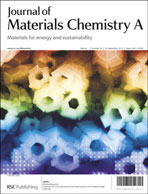Cu–Bi–Se-based pavonite homologue: a promising thermoelectric material with low lattice thermal conductivity
Abstract
Pavonite homologues, Cux+yBi5−ySe8 (1.2 ≤ x ≤ 1.5, 0.1 ≤ y ≤ 0.4), in a polycrystalline bulk form have been synthesized using a conventional solid state sintering technique. Their thermal and electronic transport properties were evaluated for mid-temperature thermoelectric power generation applications. Structural complexity, based on unique substitutional and interstitial Cu atoms in the structure, makes this system attractive as an intrinsic low thermal conductivity material; also the band structure calculations revealed that interstitial Cu atoms generate n-type carrier conduction. Room temperature lattice thermal conductivities ranging between 0.41 W m−1 K−1 and 0.55 W m−1 K−1 were found for Cux+yBi5−ySe8; these values are comparable to those of the state-of-the-art low lattice thermal conductivity systems. These extremely low thermal conductivities combined with the power factors result in the highest ZT = 0.27 at 560 K for Cu1.9Bi4.6Se8.


 Please wait while we load your content...
Please wait while we load your content...